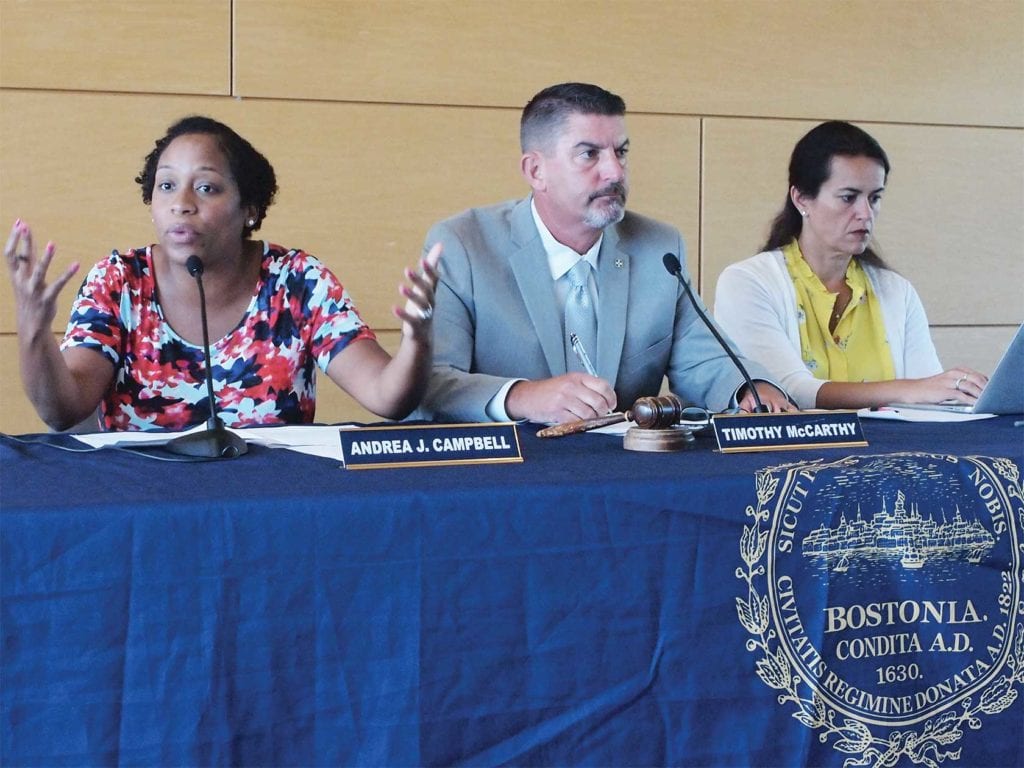Council probes city’s anti-violence funding
Campbell questions impact of city-funded initiatives

Every year, millions of dollars in federal, state and local funds go into anti-violence efforts in Boston. Last week, City Council President Andrea Campbell held a hearing to investigate the efficacy of local anti-violence efforts.
In her opening remarks, Campbell alluded to recent shootings in Mattapan and across the city that she described as an uptick in violence.
“Homicides are down, and we want to commend the work of the Boston Police Department — but shootings are up citywide,” she said. “And after any such incident, I think it’s important that we ask ourselves, ‘What are we doing about it?’ One way to respond is to make sure we have adequate resources going to violence prevention as well as intervention.”
Campbell went into the hearing with questions about what impacts the anti-violence efforts funded by the city have on the violence problem, what organizations are receiving the funds, how much is being spent and what the organizations are doing with the funds.
“My hope is that we get to a common understanding of how we measure our impact, so that we can be sure we’re using our limited public dollars most effectively,” she said. “There’s a real urgency in getting this right.”
Yet city officials who testified at the hearing offered little in the way of details on how city funds are spent.
The city’s chief of Health and Human Services, Marty Martinez, said the city approaches violence through a public health lens, focusing on prevention, intervention and response.
Under prevention, the city administers and funds programs meant to ameliorate the conditions that lead to violence, he said, “ensuring that folks are engaged in enrichment activities, programming and employment so that youth and young adults can engage in those opportunities.”
Under intervention, city staff and contractors work with gang-involved youth, formerly incarcerated individuals and others. And the response component of the city’s programming includes trauma services that come into play after an act of violence.
Martinez said the city spends $12 million a year through six departments: The Boston Centers for Youth and Families; the Mayor’s Office of Public Safety; the Boston Police Department; the Boston Public Health Commission; the Mayor’s Office of Returning Citizens; and the Office of Workforce Development.
The Street Outreach, Advocacy and Response program invests $3 million in street workers who work on prevention, intervention and response, Martinez said.
Other than that, he did not give a breakdown of the funding or an accounting of who received what. He mentioned other programs, including the Boston Police Department’s Bureau of Community Engagement and the Centers for Youth and Families.
“All of the enrichment and prevention activities in those departments are meant to … connect and engage youth and young people to resources in the community and services that are taking place,” Martinez said.
Campbell said after the hearing that she found this information insufficient. “I feel like I left the hearing with a lot more questions than answers,” Campbell told the Banner. “That tells me we have a lot more work to do.”
Campbell said she would like to see the city list the initiatives it funds on a website, along sources of funding with dollar amounts.
“These are public dollars,” she said. “At the end of the day, everybody needs to know how that money is being spent. People want to know whether what we’re spending is having an impact.”
At the hearing, other city officials testified about programs they oversee. Maria Cheevers, director of the Boston Police Department’s Office of Research and Development, described $4.2 million in federal and state grants to manage violence prevention efforts, including an anti-domestic violence initiative. She said her department passes funds through to 61 groups working on violence prevention. Roy Martin, director of the city’s Safe and Successful Youth Initiative described how his program focuses on proven-risk young people — those who are often involved in shootings.
Community members and staff from nonprofits also testified during the hearing. Project RIGHT Executive Director Michael Kozu expressed concern about how his organization’s youth program at the Burke High School is on hold for three weeks while the school is being cleaned.
“It doesn’t take three weeks to clean a school,” he said.
The Grove Hall neighborhood his organization serves has no community center offering youth program, Kozu said.
Campbell told the Banner that the community-based organizations serving youth are doing important work.
“They are having an impact,” she said. “The question is on the city side: What is the city doing with the money? What are the outcomes? All this information should be made readily available to the public.”







